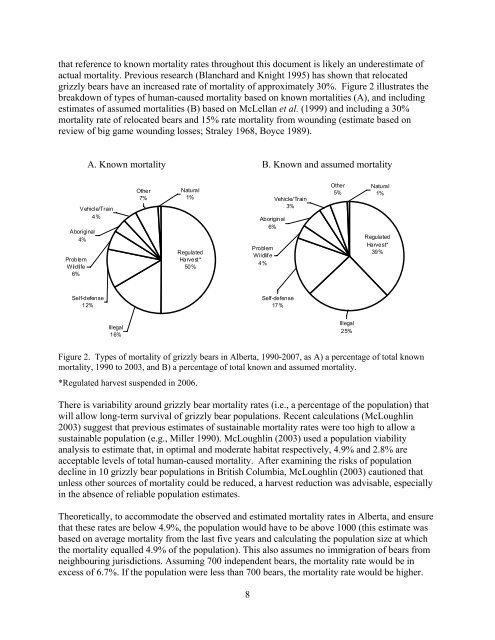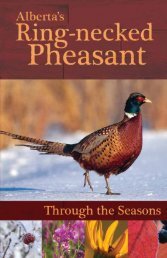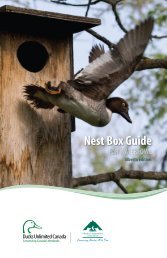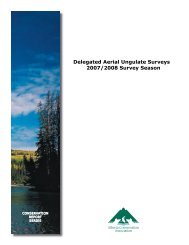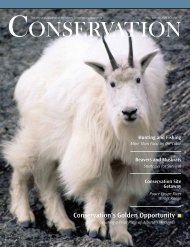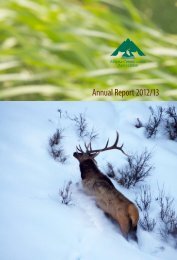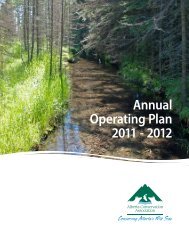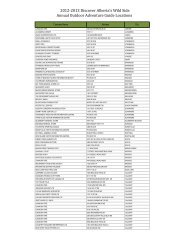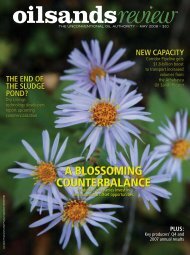Alberta Grizzly Bear Recovery Plan 2008-2013 - Alberta Sustainable ...
Alberta Grizzly Bear Recovery Plan 2008-2013 - Alberta Sustainable ...
Alberta Grizzly Bear Recovery Plan 2008-2013 - Alberta Sustainable ...
You also want an ePaper? Increase the reach of your titles
YUMPU automatically turns print PDFs into web optimized ePapers that Google loves.
that reference to known mortality rates throughout this document is likely an underestimate of<br />
actual mortality. Previous research (Blanchard and Knight 1995) has shown that relocated<br />
grizzly bears have an increased rate of mortality of approximately 30%. Figure 2 illustrates the<br />
breakdown of types of human-caused mortality based on known mortalities (A), and including<br />
estimates of assumed mortalities (B) based on McLellan et al. (1999) and including a 30%<br />
mortality rate of relocated bears and 15% rate mortality from wounding (estimate based on<br />
review of big game wounding losses; Straley 1968, Boyce 1989).<br />
A. Known mortality B. Known and assumed mortality<br />
Aboriginal<br />
4%<br />
Problem<br />
Wildlife<br />
6%<br />
Vehicle/Train<br />
4%<br />
Other<br />
7%<br />
Natural<br />
1%<br />
Regulated<br />
Harvest *<br />
50%<br />
Aboriginal<br />
6%<br />
Problem<br />
Wildlife<br />
4%<br />
Vehicle/Train<br />
3%<br />
Other<br />
5%<br />
Natural<br />
1%<br />
Regulated<br />
Harvest*<br />
39%<br />
Self-defense<br />
12%<br />
Self-defense<br />
17%<br />
Illegal<br />
16%<br />
Illegal<br />
25%<br />
Figure 2. Types of mortality of grizzly bears in <strong>Alberta</strong>, 1990-2007, as A) a percentage of total known<br />
mortality, 1990 to 2003, and B) a percentage of total known and assumed mortality.<br />
*Regulated harvest suspended in 2006.<br />
There is variability around grizzly bear mortality rates (i.e., a percentage of the population) that<br />
will allow long-term survival of grizzly bear populations. Recent calculations (McLoughlin<br />
2003) suggest that previous estimates of sustainable mortality rates were too high to allow a<br />
sustainable population (e.g., Miller 1990). McLoughlin (2003) used a population viability<br />
analysis to estimate that, in optimal and moderate habitat respectively, 4.9% and 2.8% are<br />
acceptable levels of total human-caused mortality. After examining the risks of population<br />
decline in 10 grizzly bear populations in British Columbia, McLoughlin (2003) cautioned that<br />
unless other sources of mortality could be reduced, a harvest reduction was advisable, especially<br />
in the absence of reliable population estimates.<br />
Theoretically, to accommodate the observed and estimated mortality rates in <strong>Alberta</strong>, and ensure<br />
that these rates are below 4.9%, the population would have to be above 1000 (this estimate was<br />
based on average mortality from the last five years and calculating the population size at which<br />
the mortality equalled 4.9% of the population). This also assumes no immigration of bears from<br />
neighbouring jurisdictions. Assuming 700 independent bears, the mortality rate would be in<br />
excess of 6.7%. If the population were less than 700 bears, the mortality rate would be higher.<br />
8


